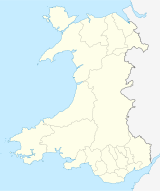Abergavenny Castle
| Abergavenny Castle | |
|---|---|
| Abergavenny, Monmouthshire, Wales | |

Interior of the surviving curtain wall and four-storey tower looking west from inside the castle grounds
|
|
| Coordinates | 51°49′12″N 3°01′04″W / 51.82002°N 3.017647°W |
| Type | Castle |
| Site information | |
| Condition | Ruins |
| Site history | |
| Battles/wars | Glyndŵr Rising, 1404 |
|
Listed Building – Grade I
|
|
| Designated | 1952 |
Abergavenny Castle (Welsh: Castell y Fenni) is a ruined castle in the market town of Abergavenny, Monmouthshire, Wales, established by the Norman lord Hamelin de Balun in about 1087. It was the site of a massacre of Welsh noblemen in 1175, and was attacked during the early 15th century Glyndŵr Rising. William Camden, the 16th century antiquary, said that the castle "has been oftner stain'd with the infamy of treachery, than any other castle in Wales."
It has been a Grade I listed building since 1952.
The castle is located immediately to the south of the town centre. It was built by the Normans to overlook the River Usk and its valley, and so guard against incursions into the lowland areas south and east of the town by the Welsh from the hills to the north and west.
The castle, now in ruins, had a stone keep, towers, and ditch as fortifications. It also housed the family and army of the lord and had cellars, kitchens, a great hall, gatehouse, and a chapel, although it is doubtful whether any of the families treated the castle as their main residence. A curtain wall surrounded the castle.
The high, formidable curtain wall, dating from the 12th century, is now the most impressive part of the ruin. A 19th century lodge was built on the top of the motte in the 19th century.
Hamelin de Balun, a Norman lord, had the castle built about 1087. Protected by a ditch and palisade, the motte was surmounted by a wooden keep. Soon after 1100, a stone keep was built to replace the wooden structure, and a wooden hall was built on its western side.
In the 1160s, Henry Fitzmiles, the son of Miles de Gloucester, 1st Earl of Hereford and lord of Abergavenny, was killed, reputedly by Seisyll ap Dyfnwal of Castell Arnallt. Without a male heir, Henry Fitzmiles' estate and the lordship, which included lands in upper Gwent and Brecknockshire, as well as the Castle, passed to his daughter Bertha's husband, William de Braose. De Braose rebuilt parts of the castle and constructed the curtain wall, parts of which still remain.
...
Wikipedia

